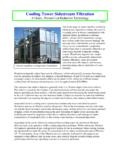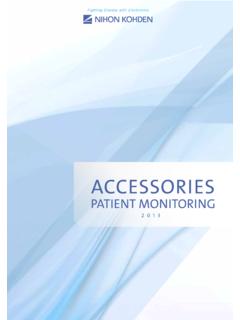Transcription of Treatment of Industrial Wastewater by Membrane …
1 UNESCO EOLSSSAMPLE CHAPTERSWATER AND Wastewater Treatment TECHNOLOGIES - Treatment of Industrial Wastewater by Membrane Bioreactors - Chettiyappan Visvanathan Encyclopedia of Life Support Systems(EOLSS) Treatment OF Industrial Wastewater BY Membrane BIOREACTORS Chettiyappan Visvanathan Environmental Engineering and Management Program, School of Environment, Resources and Development, Keywords: Membrane bioreactor (MBR), Industrial Wastewater , Treatment , Membrane Technology, Research Contents 1. Introduction 2. Design of MBR system Membrane System Design Reactor Design for MBR System 3. Operation of the Membrane System in MBR 4. Application of MBR in Industrial Wastewater Treatment 5. Conclusions Glossary Bibliography Biographical Sketches Summary Membrane Bioreactors (MBRs) have attracted a significant attention of scientists and engineers in the past two decades.
2 Improvement of Membrane technologies coupled with experiences gained from application of membranes in different Industrial processes have opened a gamut of opportunities in Industrial Wastewater Treatment . The solid-liquid separation that is conventionally carried out in gravity-based clarifier is replaced by Membrane filtration in a MBR system thus combining the strength of biological Treatment processes and efficiency of Membrane filtration. This and several other advantages have made the MBR system ideally suited for Treatment of strong Industrial Wastewater and reclamation of water. By late 1990s many commercial application of MBR can be noted in industries and each year this number is increasing rapidly. Researches on MBRs are increasingly funded by municipal councils, industries, Membrane and packaged Wastewater Treatment plant manufacturers, which is a clear sign of popularity and potential of MBR.
3 In this chapter, an attempt has been made to explain MBR systems and their advantages and drawbacks over conventional biological Treatment systems. The implications of such advantages on the design and operation of MBR are discussed. A number of case studies from commercial applications and researches have been put forward to demonstrate the forte, robustness and flexibility of MBR systems in treating different types of Industrial Wastewater . This is expected to give the reader a good understanding of MBR system, which is considered as one of the best available technologies in the field of Wastewater Treatment . UNESCO EOLSSSAMPLE CHAPTERSWATER AND Wastewater Treatment TECHNOLOGIES - Treatment of Industrial Wastewater by Membrane Bioreactors - Chettiyappan Visvanathan Encyclopedia of Life Support Systems(EOLSS) 1.
4 Introduction Researches on Membrane bioreactor (MBR) date back to as early as 1960s. However, commercial use of Membrane in Wastewater Treatment remained limited primarily due to low Membrane flux, low permeability, limited Membrane life and high cost of Membrane . From early 90 s due to active researches in the field of Membrane technology, a new generation of membranes evolved that dramatically overcame many of the above limitations and the cost of membranes started to decline. This attracted a lot of attention to commercial use of membranes in Wastewater Treatment . By then use of membranes in other fields of Industrial applications including water Treatment was common and lot of experiences already gained.
5 During the same time due to increased environmental awareness, effluent discharge legislations were tightened in several countries. Limitations of conventional biological processes in treating Industrial Wastewater to meet the discharge standards became more apparent. This led to significant number of researches being directed to alternative technologies and improvement of existing technologies. Consequently, researches on MBR picked up and many of these were actively supported by industries. Initially, many researches were focused on treating domestic/municipal Wastewater using MBR. Later and more recently, the possibility of using MBR in different types of Industrial Wastewater Treatment has gained much attention. Figure 1 Schematic Arrangement of a typical Membrane bioreactor MBR is a major attempt to increase the efficiency of conventional biological Wastewater Treatment processes by replacing the gravity-based clarifier (used to separate the active biomass from the mixed liquor) by a Membrane -aided pressure filtration process.
6 The underlying principle of removal of pollutants by biochemical reaction however remains UNESCO EOLSSSAMPLE CHAPTERSWATER AND Wastewater Treatment TECHNOLOGIES - Treatment of Industrial Wastewater by Membrane Bioreactors - Chettiyappan Visvanathan Encyclopedia of Life Support Systems(EOLSS) same in a MBR as in conventional systems. The schematic arrangement of a typical Wastewater Treatment train using MBR is given below, Figure 1. As a result of replacing the secondary clarifier by a pressure based Membrane filtration process several improvements can be achieved like: The performance of solid-liquid separation efficiency is improved due to higher efficiency of Membrane filtration over gravity separation; The sensitiveness of the separation process to the internal and external factors can be reduced thereby improving the reliability of the system; Control on several process related factors can be improved like sludge retention time (SRT) or mean cell residence time, organic loading, waste sludge volume and characteristics etc.
7 That can improve the efficiency of the biochemical reaction process; Removal of nutrients and refractory (biodegradation-resistant) substances can be improved; Complete removal of microorganisms and pathogens from effluent is possible that reduces the disinfection requirement; Less operation control during steady state condition as well as rapid initial process startup can be achieved; The footprint of a traditional Wastewater Treatment plant can be reduced by replacing large (clarifier) tanks with compact Membrane modules; Better effluent quality from MBR easily lends itself to opportunities of reclamation and recycling of Wastewater . Each of these improvements justifies the use of MBR in Industrial Wastewater Treatment .
8 While the characteristics of raw domestic sewage are predictable, characteristics of Industrial Wastewater vary widely and are often many times stronger. In addition, intermittent and shock loading, unstable pH, high temperature, turbidity, color, presence of toxic and refractory substances is common with Industrial Wastewater . As a result, Industrial wastewaters are much more difficult to treat and in many cases, large elaborate Treatment systems are required. Yet even with such systems, effluent quality (meeting discharge standards) is not guaranteed. Therefore, MBR systems with higher efficiency offer a better solution to industries. Performance of gravity-based clarifiers is poised on the small difference in the specific gravity of the flocculated biomass and the mixed liquor.
9 As a result, these clarifiers are highly sensitive to a number of internal and external factors, for example pH, temperature, SRT, solid loading etc which need strict operational control. This increases the cost of operation and maintenance and decreases the reliability of the system. On the other hand, Membrane separation, which uses pressure filtration across a selective Membrane is a more reliable system and has been widely used in different fields of engineering. Moreover, membranes can be tailored to suit particular application conditions ( higher temperature or turbidity) and performance can be stabilized even when substantial variations of such conditions take place. This makes the MBR system reliable and robust that is needed for Industrial applications.
10 UNESCO EOLSSSAMPLE CHAPTERSWATER AND Wastewater Treatment TECHNOLOGIES - Treatment of Industrial Wastewater by Membrane Bioreactors - Chettiyappan Visvanathan Encyclopedia of Life Support Systems(EOLSS) Better control on process related factors can be achieved during both design and operational phases that improves the overall efficiency of the system. This will be discussed in detail later. Operational control gives more opportunity to the operator to tune the process according to the demand (like intermittent or shock loading, variation of pH, temperature, increase in turbidity etc.). MBRs have shown better performance concerning nutrient removal. Higher SRT or mean cell residence time in the reactor promotes growth of slow-growing nitrifiers (nitrosomonas and nitrobacter) that remove nutrient from Wastewater .















